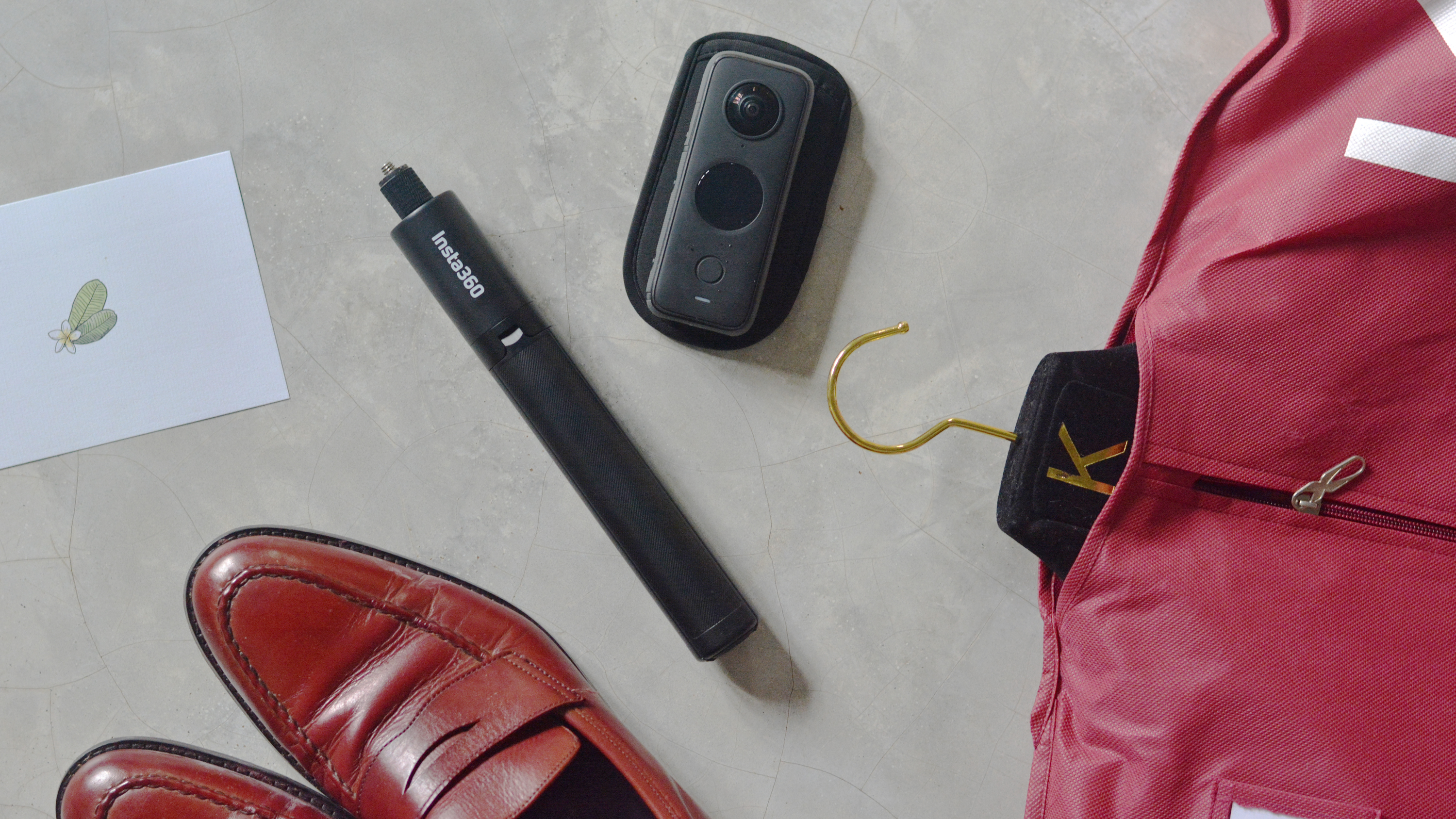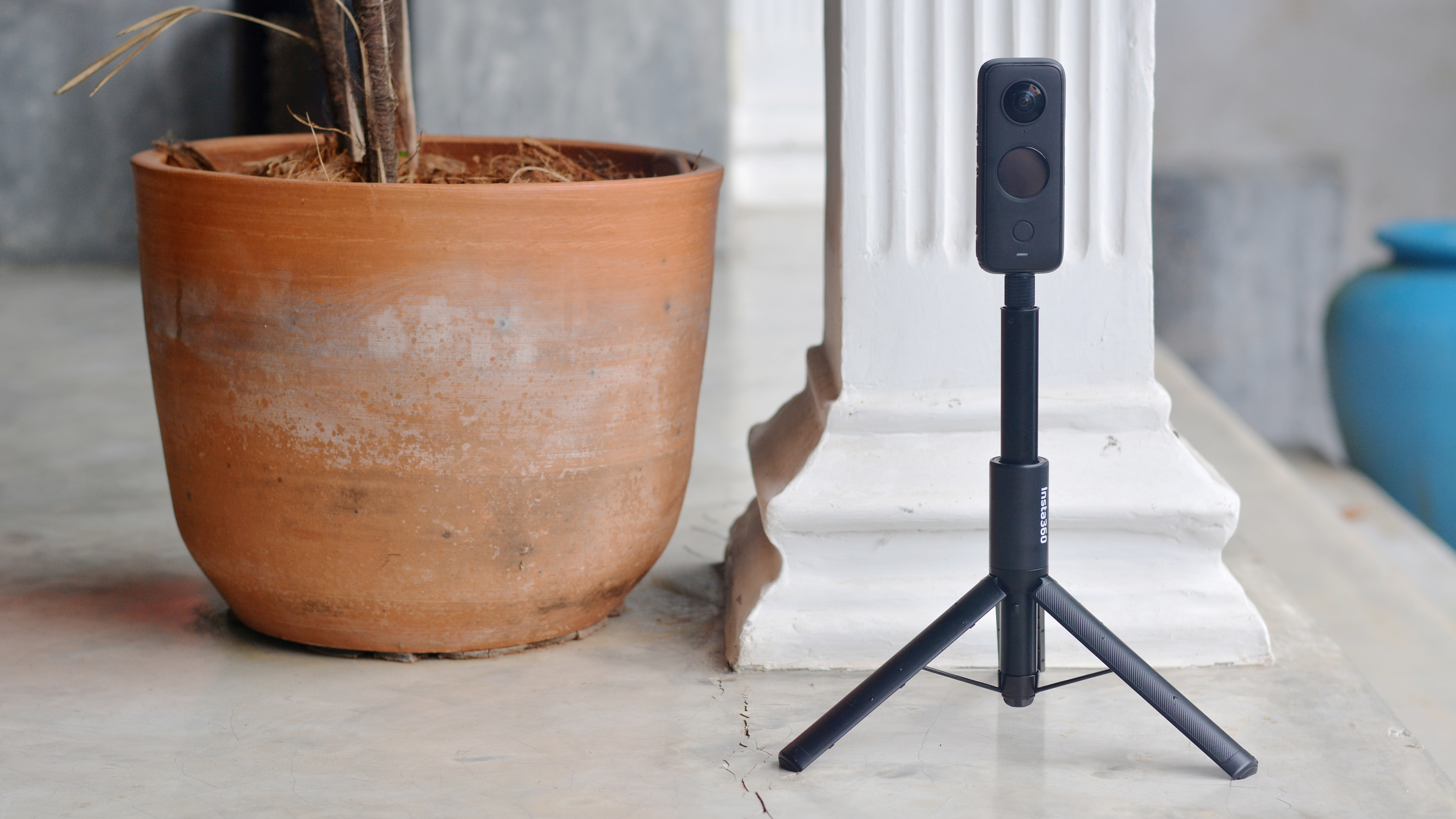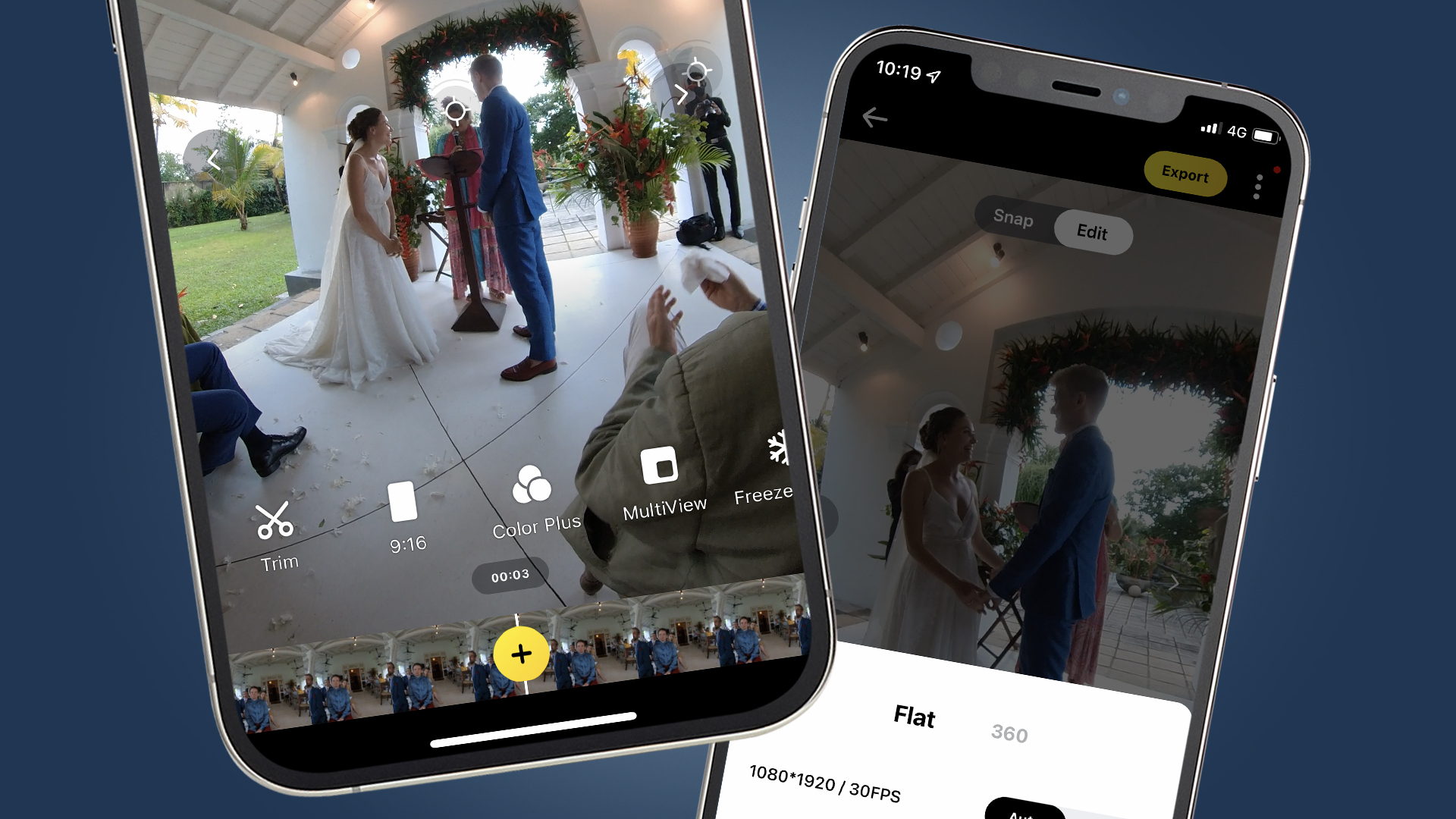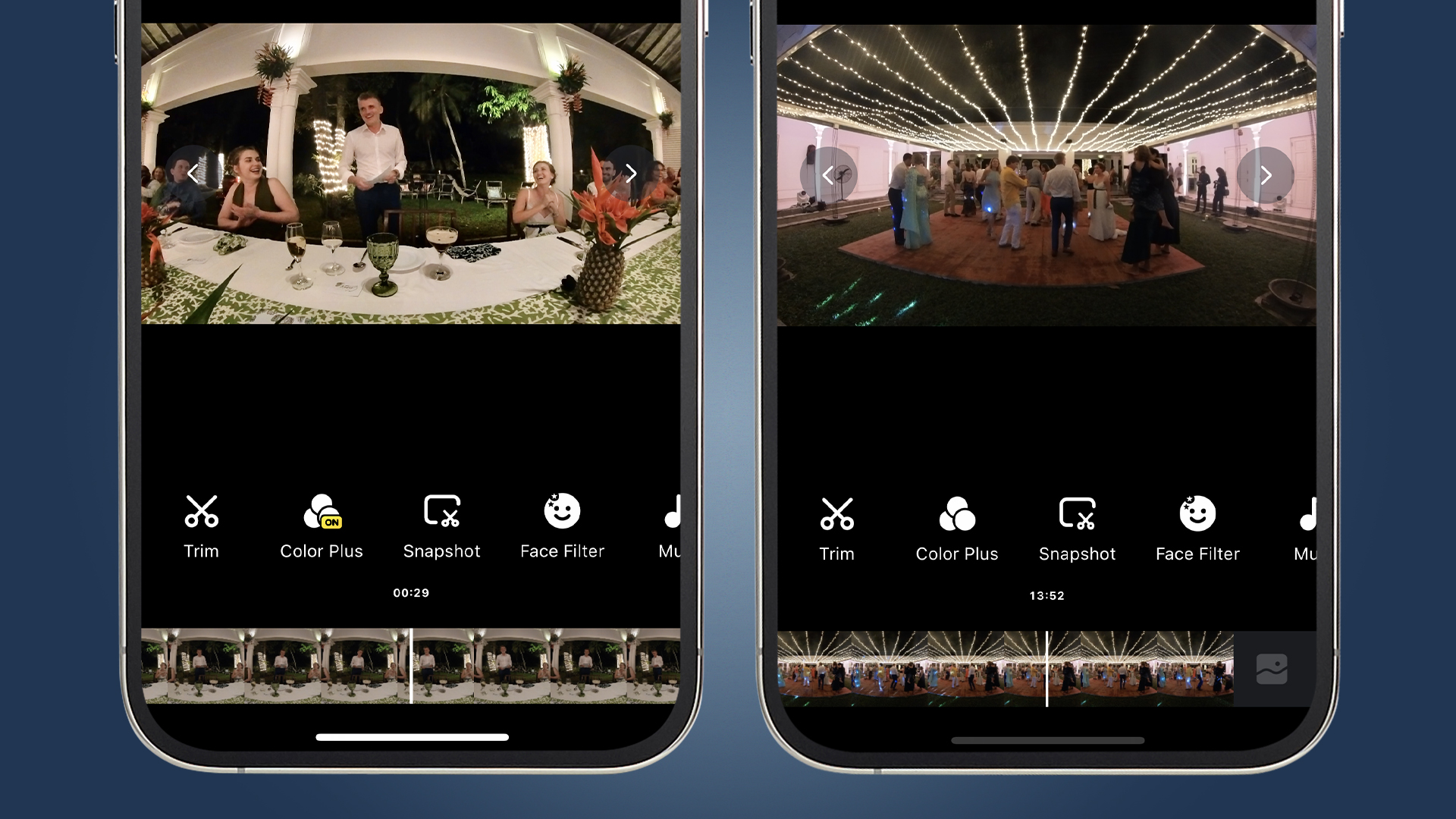I swapped my wedding photographer for a 360 camera – and the risk paid off
How to shoot your own ceremony in 360

While preparing for my wedding, one question I didn’t expect to hear so regularly was, “who’s filming the ceremony?” The answer that I gave was equally unexpected: “I’m recording it myself. With a 360 camera.”
But that’s exactly what I did. After the cost of the photography team left us sweating with fear for our financial stability, the idea of shelling out further for a full videography setup was simply out of the question.
Don’t get me wrong: I understand the value – and appreciate the work – of imaging professionals, especially at events as significant as weddings. If money was no object, my wife and I would have loved to have a movie of our big day captured in 4K. I can see it now: the soft focus as we walk down the aisle, the artful bokeh as champagne glasses clink, the slow-mo of me stumbling on the dance floor.

Alas, as for so many couples on the path to marital bliss, money was an object. So instead of breaking the budget in the name of frame rates, I instead had the bright idea to use a 360-degree camera to record every angle of the ceremony.
Fully-charged, positioned on a tripod halfway up the aisle and operated with military discipline by my best man, it still wouldn’t capture the creative angles or full-frame quality that a videographer could. But it would record every word and wiped eye at our wedding, for quite a lot less cash. At least, that was the plan.
Why did I choose a 360 camera?
Having decided to film our own wedding, a 360 camera was the obvious tool for the job. Sure, a standard DSLR or mirrorless camera on a fixed tripod could have captured a clear angle of the ceremony. But in the right position, a 360 camera would offer unrivaled immersion by shooting the entirety of the nuptial scene – audience and all.
More than a spherical novelty, it would also give me unlimited editing options after the fact. I’d be able to crop in on flat frames from anywhere within the resulting 360 footage.
Sign up for breaking news, reviews, opinion, top tech deals, and more.

So I could select and export footage of my beautiful wife arriving, then pan the video around to save a clip of my father-in-law simultaneously dabbing his eyes.
And because it would capture the whole spectacle by itself, a 360 camera could be set and left with minimal hassle. Which is the gold standard for any wedding day plan.
The 360 wedding setup
Three contenders vied for the videography job: the GoPro Max, the Insta360 One R Twin Edition and the Insta360 One X2. Each put forward compelling pitches, but the One X2 won the gig for several reasons.
Its interface is accessible, even with hands made wobbly by wedding nerves. Its understated design wouldn’t distract guests from the main event. It also produces dynamic 360 footage that’s seamlessly stitched, while the smartphone app is one of the most comprehensive for creative editing. Plus it can shoot standard widescreen video at 1440p using one lens. It’s significantly less expensive than a videography team, too – and unlike a videography team, I can take it on the honeymoon.

Cleverly, the One X2 can also remove Insta360’s ‘invisible’ attachments from footage using automatic masking. Fitted atop the '2-in-1 Invisible Selfie Stick + Tripod', for example, the mount magically disappears as if Casper is holding the camera. The stand itself is ideal for wedding duties: much less bulky than a traditional tripod, its flip-out feet and low profile meant it flew under the radar while standing to one side of the aisle.
I had to stream video from the Insta360 One X2 during the edit, which pushed the limits of wireless transfer rates – and caused my iPhone to sweat harder than I did at any point on my wedding day.
Completing the package was a microSD card fast enough to cope with the demands of processing 360 footage and large enough to keep recording even if proceedings ran over. On Insta360’s recommendation, I opted for a 64GB SanDisk Extreme Pro V30 A1 card. I also doubled up with a second microSD card and backup battery – the idea being that I could quickly switch in the fresh accessories between the ceremony and the speeches.
My Insta360 One X2 bundle also included a simple but indispensable rubber lens cap. Those big glass eyes are vulnerable to scratches and, with the camera due to stand in wait while setup went on around it, the extra protection made sense.
How well did it work?
On a day with a million moving parts, the Insta360 One X2 was mercifully easy to work with. A few hours prior to proceedings, I was able to enjoy a moment of solitary reflection at the ceremony venue: reflecting on where to position the camera.
The Insta360 One X2 has a neat circular touchscreen, which proved handy for on-the-spot framing later in the evening. But to be sure I had it in the best position for the ceremony, I paired it with my smartphone via Wi-Fi and Bluetooth for a live 360 preview feed through the app. After a bit of panning and shuffling, I settled on a spot at the end of the first row of chairs. This gave the closest thing to a head-on aspect, without obstructing the aisle – or anyone’s sightline.

I opted not to change the camera from its standard settings: full-round 5.7K footage at 30fps is the Insta360 One X2’s best – and with no extreme sports listed in the program, it was just what we needed. I also kept its FlowState stabilization smarts enabled, to counter any swaying of the slender tripod pole if things got breezy.
It was a relief to glance at the recording light and see that the little 360 camera had everything covered. And because it did, guests could keep their smartphones away and simply enjoy the moment.
The walkthrough with my wingman was painless: press the power button, press the record button, wait for the red light. True, we could’ve employed a smartphone to trigger the video, but that would’ve still required the camera to be switched on. Equally, we could’ve used Insta360’s GPS Smart Remote, but that would’ve meant extra expense.
In reality, there was reassurance in the simplicity – and in the physical confirmation that the right buttons had been pushed and the light was blinking. Especially as I would be hiding in a different room, my inner control-freak itching but unable to check the setup for myself.

And it worked without a hitch. It wasn’t my top priority when I made my grand entrance (honest), but it was a relief to glance at the recording light and see that the little 360 camera had everything covered. And because it did, guests could keep their smartphones away and simply enjoy the moment. It also meant we didn’t have the pressure of a second set of barrels bearing down on us, the shutterbugs from the photography team already trained on my every awkward expression.
In a quiet minute after the formalities were concluded, I came back for the camera. Having been left to run for around an hour, it had maxed out its memory card and switched itself off. I swapped out the microSD, reminded myself that now wasn’t the time to review the footage, fitted the backup cell and nipped through to the reception area to position it for the speeches. Thanks to the endorphins and bubbly now in my bloodstream, I was a little less fastidious with positioning it this time. Luckily, the Insta360 One X2 offers champagne-proof accessibility.
How did I edit my 360 wedding video?
One of the main reasons for selecting the Insta360 One X2 was its excellent smartphone app. Available for free, it features a raft of tools for creative tweaking. While it’s possible to save the spherical footage – meaning I can re-live my wedding day at any time by strapping on a set of VR goggles – the more useful export for most people (myself included) is a flat frame taken from within the 360 video.
When you’ve recorded something as important as your wedding, there’s an inherent fear of corrupting or losing the footage. Having suffered a mild heart attack when I couldn’t find the Insta360 One X2 on the morning after the wedding (foiled by my own late-night brainwave to hide it in a shoe), I made sure to back up the files twice before doing anything else – both to a hard drive and to the cloud. Which, given the sheer size of 360 video, required a lot of space and bandwidth.
That file size almost makes hefty demands of a smartphone. There wasn’t enough space on my iPhone X to save the footage to local storage, so I had to stream video from the Insta360 One X2 during the edit. Which pushed the limits of wireless transfer rates – and caused my iPhone to sweat harder than I did at any point on my wedding day.

But stutters aside, the Insta360 app made a potentially overwhelming process into something intuitive. There’s a lot to digest (so many expressions on display) and the task is obviously more involved than if I’d left the editing to a professional outlet.
Even so, the process of exploring the 360 footage, dropping pins to highlight key moments and watching as the app automatically transitions between positions in the resulting edit doesn’t get old. Likewise, the app’s subject-tracking and auto-framing smarts work like magic.
Looking at the footage captured by the Insta360 One X2, I’m chuffed with the decision to film our own wedding day. The result is an immersive video that we can watch again and again.
If you’re more of a real-time director, you can set the app to record your path as you pan around the footage. I can never get this quite right, as it requires fingers defter than my own to pinch and zoom smoothly. But because the original video is endlessly editable, I’m enjoying the continued experiment – finding something new each time I rewatch.
Exporting proved straightforward and pretty speedy, even when I was streaming source material from the camera. Color enhancements did lead to longer processing times, but also made for more vibrant results.
What would I have done differently?
Looking at the footage captured by the Insta360 One X2, I’m fundamentally chuffed with the decision to film our own wedding day. The result is an immersive video that we can watch again and again, noticing something different every time we do. Arguably just as important is the fact that capturing it was easy and didn’t interrupt the day.
That said, there were obviously compromises involved. Even with a full sphere of coverage, some moments were missed. For example, while you can see me arriving on a Royal Enfield in front of the ceremony venue (yes, really), it takes place too far from the camera to crop in for a clear shot. Though the Insta360 One X2 shoots at a 5.7K resolution, those pixels are spread across the full 360, so you simply can’t zoom in beyond a certain point.
A second 360 camera was in no way a necessity, but it would have been a nice luxury. Knowing now how simple it was to set up a single Insta360 One X2, an additional camera would’ve introduced minimal extra stress, while giving a welcome second angle of proceedings. Then again, it would’ve meant twice as much footage to download and review.
In truth, the only thing I wish I’d done is record more of the reception. With Insta360’s Extended Edition Selfie Stick, for example, I could’ve captured some drone-like shots of the hopping courtyard dance floor. And if I was a risk-taker, I could have dared to try a spinning slow-mo shot by whipping the Bullet Time Cord around above my head.
But after all the planning that went into our wedding, I also forgive myself for enjoying the party, rather than fiddling around with camera gear. After all, I’ve got a lifetime of wedded happiness to spend doing that.

For more than a decade, Chris has been finding and featuring the best kit you can carry. When he's not writing about his favourite things for Stuff, you'll find Chris field-testing the latest gear for TechRadar. From cameras to classic cars, he appreciates anything that gets better with age.